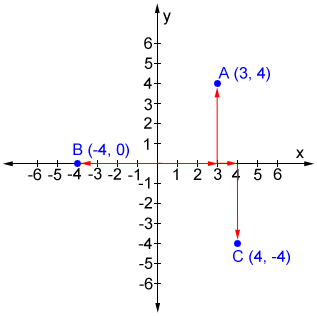

But if we use only one of the two coordinates, say either x or y, we get confusion at certain points (namely near the points (1,0) and (-1,0) for x, and near (0,-1) and (0,1) for y). I.e.although the pair of numbers (x,y) does suffice to describe any point of the circle, we prefer to have only one number as a coordinate on the circle, since the circle is only "one dimensional". In this example, we do not need more than one coordinate system since the domain of our coordinate functions is in both cases the whole quadrant, and a more typical example can be made using the unit circle x^2+y^2 = 1. in the upper right quadrant of the plane, we can use either cartesian coordinates (x,y) which are functions from point to pairs of numbers, or we can use polar coordinates (r, theta), which are also functions from points to pairs of numbers, or we can compose these and get coordinate change functions, such as x = r.cos(theta), y = r.sin(theta), or theta = arctan(y/x), r = sqrt(x^2+y^2). Thus we have several types of functions coming from coordinate systems on a manifold, namely functions from points to numbers, called "coordinates", and then we have their inverses, functions from numbers to points, called "parametrizations", and finally we have functions from numbers to numbers obtained by composing parametrizations with coordinates, called "coordinate changes".Į.g. We can also do this in the other order, namely if we have only one coordinate function f, defined near p, with value f(p)= x, and if we also have any function from numbers to numbers, defined near x, say y(x), we can compose these and obtain a new coordinate function g(p) = y(x) = y(f(p). if we have two coordinate functions defined near the same point, then we do get a composition which expresses one coordinate as a function of the other coordinate. In this case one can ask another question, given the coordinate f(p) = x, of the point p assigned by the coordinate function f, what is the coordinate g(p) = y, of that same point but assigned by the coordinate function g? This yields a composition function y(x), from numbers to numbers. In this case it often happens that the domains of two different coordinate functions f,g can overlap, so that the same point p of M can be assigned two different coordinates, one by one coordinate function f and another by a second coordinate function g. In particular, both coordinates and their inverses are viewed as functions, one goes from points to numbers, and the other goes from numbers to points.īecause of the complicated shape of the manifold, the domain subset of a given coordinate is usually not the whole manifold, so it is usually necessary to use more than one coordinate function, in order to cover the whole manifold. This views the inverse function of a coordinate function also as a function, namely a function from sequences of numbers, back to geometric points. One can also ask the inverse question, namely given a number (or sequence of numbers), one can ask what point in the domain subset of a given coordinate, is the point having the given coordinate. what numbers are assigned to that point by that coordinate function. Thus given a point in the domain subset of a given coordinate, one can ask what is the coordinate of a point in that subset, i.e. Thus a coordinate is a function defined on some (open) subset of the points of M, with values which are numbers. A coordinate is a number (or sequence of numbers) assigned to such a point. A manifold is a geometric object M made up of "points".


 0 kommentar(er)
0 kommentar(er)
